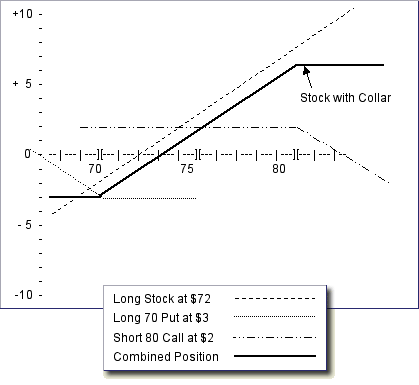Protective Puts Using The Collar Strategy During Volatile Markets
Post on: 30 Июнь, 2015 No Comment

As safe a strategy as covered call writing is there is some risk; the risk is in purchasing the stock, not in selling the option. For this reason, some investors who sell covered calls also buy protective puts to alleviate some of the risk especially in volatile markets like weve experienced recently. Remember, the owner of a put option has purchased the right, but not the obligation, to SELL 100 shares of the underlying stock at the strike price on or before expiration Friday. A put option is considered in-the-money if the strike price of the put option is higher than current market value of the underlying stock. Likewise, a put option is considered out-of-the-money if the strike price of the put option is lower than the current market value of the underlying equity. You will note that the in-the-money and out-of-the-money strike/share value relationships are opposite for calls and puts.
A protective put is a put option that is purchased for an underlying stock that is already owned by the put buyer. It defends against a decrease in the share price of the underlying security. When a protective put is used in conjunction with covered call writing, the strategy is referred to as a collar strategy. A collar is the simultaneous purchase of a protective put option and the sale of a covered call option. In a true collar strategy, the puts and calls are both out-of-the-money and have the same expiration dates and an equal number of contracts. Thus, we sell an out-of-the-money call and add additional downside protection for the underlying equity by purchasing a protective put option.
• Buy 1 $45 (O-T-M) put option for $1
• Net gain on the option buy and sale is $100 ($200 – $100)
• This brings our cost basis down to $4700 ($4800 – $100)
Possible outcomes
- Outcome if stock price surpasses the $50 strike price :
Shares are sold for $5000 ($50 strike price x 100 shares)
ROO = $100 ($100/$4700) = 2.1%
The chart below depicts the risk profile and possible outcomes of the collar for this particular example:
Risk-reward profile for the collar strategy
As demonstrated in the chart above, the profit potential of an otherwise normal covered call position (dotted line) is muted due to the additional cost of purchasing the protective put (solid line); however, the protective put also gives us downside protection at the strike of the put. If you exit the covered call position early, you can sell the remaining protective put, thus slightly improving your return.
Here is an options chain for EBAY, a stock on our current Premium Watch List showing possible call and put selections for the collar strategy:
The use of protective puts when covered call writing will decrease downside risk but also result in a lower initial premium return. The collar strategy is particularly useful in volatile or bearish markets. There are other strategies that can be executed during volatile market conditions. These are detailed in the BCI Emergency Management Report located the resources/download section of the premium site .
Live in the Chicago area?
I will be the keynote speaker on Saturday November 10th:
AAII Chicago Chapter:
The pattern of mildly positive economic reports continued this past week:
- On Wednesday the Federal Reserves press release called the economy expanding at a modest pace
- The GDP rose back to the 2% pace we saw in the first quarter
- Most of the GDP improvement came from the all-important consumer spending
- New home sales rose by 5.7% over the August pace and 11.7% higher than September, 2011
- Home inventories declined to the lowest level since 2005
- The median sales price of homes in September was 11.7% higher than in September, 2011
- The Fed reiterated its intention to keep short-term interest rates between 0% and 0.25% at least through mid-2015
- New orders for manufactured goods rose 9.9% in September
For the week, the S&P 500 fell by 1.5% for a year-to-date return of 14%, including dividends.
BCI. Despite the favorable economic reports, the disappointing earnings and market volatility dictates taking a defensive posture favoring in-the-money strikes, low-beta stocks and ETFs. Less experienced investors should consider keeping at least a percentage of their portfolios in cash until volatility subsides.
East coast members please stay safe as the storm passes.














